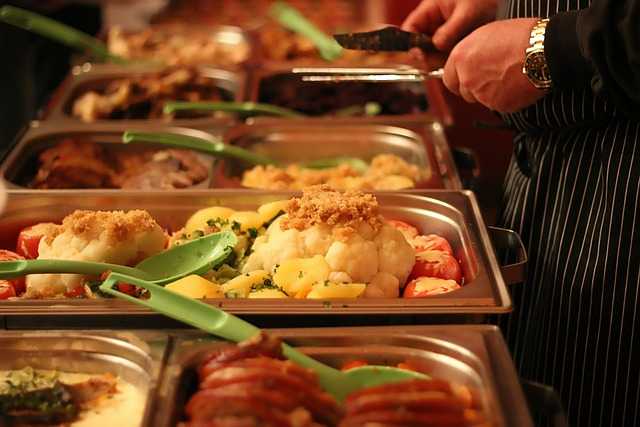When I worked for Digital Equipment Corporation, Ron Brown, my boss at the time, implemented a rather interesting organizational change one day. When I asked him where he discovered the concept, he said from Architectural Digest. Since that time, I have always looked for business lessons in unexpected places.
In the world of business, learning business lessons from unexpected sources can often yield valuable insights. One such surprising teacher is the humble food buffet, which offers a wealth of experiences that can be translated into essential lessons for small business owners. Let’s explore how buffet strategies can be translated into actionable examples for entrepreneurs.
Related post: 4 Super Valuable Business ROI Lessons From Publishing
Stepping into a buffet is like entering a world of culinary abundance. Yet, beneath the enticing spread lies a masterclass in profit maximization based on an acute understanding of customer psychology. As small business owners seek inspiration from unexpected places, the buffet experience offers valuable lessons to ensure long-term success and profitability.
Strategic Placement of Options
Buffets place serving plates at the end of the buffet line to encourage customers to begin selecting foods near the plate stands. From that location, the buffet strategically places items that will take up the most space on the plate and cost the least to provide nearest the starting line by encouraging diners to load up their plates with these options first. The buffet ensures that customers have less room for other products, which often cost them more by volume and are placed further down the line. For example, salads are followed by vegetables long before you get to the proteins, which cost the buffet more to provide. By the time the buffet customer gets to the meat section, there is often very little room left on the plate. Moreover, the items at the end of the line often have a limited shelf life, cannot be reheated, and take more time and effort to prepare, so giving out less is better for the buffet.
This strategy is effective for businesses that offer a kind of subscription where a customer pays a fixed price upfront and then is allowed to consume as many products or services as they want. Rather than plate space, time is often the limiting factor.
I recently took my grandson Dominik to an adventure park. Near the entrance was a popular gondola ride. The ride had a long line that consumed nearly an hour of our day as we waited for our turn. When we reached the far end, we had three choices: wait in line to take the gondola back to our original starting point, wait in line for another popular Skycoaster ride, or take a long walk past several food vendors, many older and minor attractions with smaller lines to a bridge that took us back to the entrance area where there were many of the other attractions that also had long lines. The park strategically placed its attractions so that visitors spend most of their time waiting in long lines or walking great distances between the most popular attractions. Their attraction placement strategy made it more attractive to spend most of one’s time on minor attractions to avoid waiting in long lines.
Creative Pricing Strategies – Add-ons
Buffets often employ creative pricing strategies to maximize profits. One example is charging separately for drinks and offering larger glasses filled with more ice. Customers perceive the larger glass as offering more value, but the extra ice reduces the amount of actual beverage served. As a result, the business can save on the cost of drinks while maintaining customer satisfaction.
Photographers sometimes offer their clients a digital copy of a photo they can use as a screen saver or other digital display if they order an 8×10 print for an additional fee. The cost to provide the digital copy is virtually nothing for the photo studio. Still, it makes the customer perceive the additional value of the photography service and allows the studio to receive some additional revenue.
Focus on High-Margin Items
Buffets often provide unlimited supplies of cheap-to-produce items, such as soft drinks, which have high profit margins. By emphasizing these items, they can offset the cost of more expensive offerings while giving customers a sense of abundance.
Many retailers offer an extended warranty. While the typical profit margin for a retailer is between 15% and 20%, the profit margin for an extended warranty is generally more than 200%.
The Power of Perception
An “all-you-can-eat” buffet tagline creates a perception of value based on volume, even if customers might not consume an overwhelming amount of food. This psychological tactic plays on the human desire to get the most for one’s money, giving the impression that the buffet experience is a great deal.
Bulk retail stores or warehouse clubs sell products in bulk. Selling in bulk lowers the retailer’s operating expenses in various ways while also lowering the unit cost for the consumer. The additional quantities purchased by the consumer often spoil before they are consumed or become obsolete in terms of product lifespan before being entirely used up.
Guiding Consumer Choices
Buffets often use different-sized utensils for different types of food. They may provide larger spoons for dishing up cheaper items and smaller, clumsy tools for more expensive dishes. I recall once trying to serve myself bacon-wrapped scallops with what looked more like a spatula. For one, I could only load one at a time using the utensil provided, and it frequently rolled off and back into the chafing dish before I could add it to my plate. This type of approach influences customer behavior by subtly guiding them towards cheaper options while making the more expensive items appear scarce and exclusive.
As a consultant, offering a one-on-one experience creates an earning limit based on how much you can charge for an hour or your time and the number of hours you can work. Delivering a course to many clients allows you to make more money in a given hour of work while reducing the unit cost for the customer.
Leveraging Peer Pressure
In a buffet setting, the time pressure created by the presence of other diners in line behind you for a popular, high-value food item and one that is expensive to deliver may prompt some customers to rush their selection and ultimately take fewer expensive food items. Peer pressure keeps the line moving and encourages customers to take fewer products with lower margins.

My son Hank works in a retirement community that occasionally has an open house that includes tours of the facility, a band, and even a car show. These events are open to the families of the residents and even the local community for a small fee. The serving time is generally narrow between events, so they have several serving lines to expedite the meal service, where people can fill their plates with side dishes as well as burgers, hotdogs, and chicken during the intermission. However, they only have one line to access the carving station, serving more expensive proteins such as roast beef, brisket, or ham. The line for the carving station is always longer, and the slow meat-cutting process means that many people settle for a smaller portion so as not to feel gluttonous toward those still in line.
Dog trainers often deliver one-on-one obedience training sessions for dogs in blocks of 30 minutes to an hour each. They are often delivered at a local park and are scheduled back-to-back. This way, clients who may want to sneak in more than their allotted time with the trainer are encouraged to leave promptly at the end of their lesson to avoid taking time from the next client, who they can see is patiently waiting for their lesson to begin.
Conclusion
Business owners can learn valuable business lessons from unexpected sources if they keep their eyes open. The unassuming buffet stands as a surprising teacher for small business owners. Beyond the bountiful spread of culinary delights, buffets offer a masterclass in profit maximization rooted in customer psychology. By strategically placing products, utilizing creative pricing tactics, focusing on high-margin items, and leveraging the power of perception, entrepreneurs can apply buffet practices to optimize revenue and customer satisfaction. Moreover, guiding customer choices and harnessing the influence of peer pressure can encourage efficient decision-making and productivity. By embracing these buffet-inspired strategies, small businesses can carve a path to success.
But don’t stop there. Look at other industries for inspiration and business lessons. After visiting a meat processing plant, Henry Ford drew inspiration and learned business lessons for his automotive assembly line. Brian Chesky, the founder of Airbnb, also drew inspiration and business lessons on how to build consumer trust by looking at the eBay model of buyers and sellers rating their experience.
What unexpected lessons can you draw from other industries?












